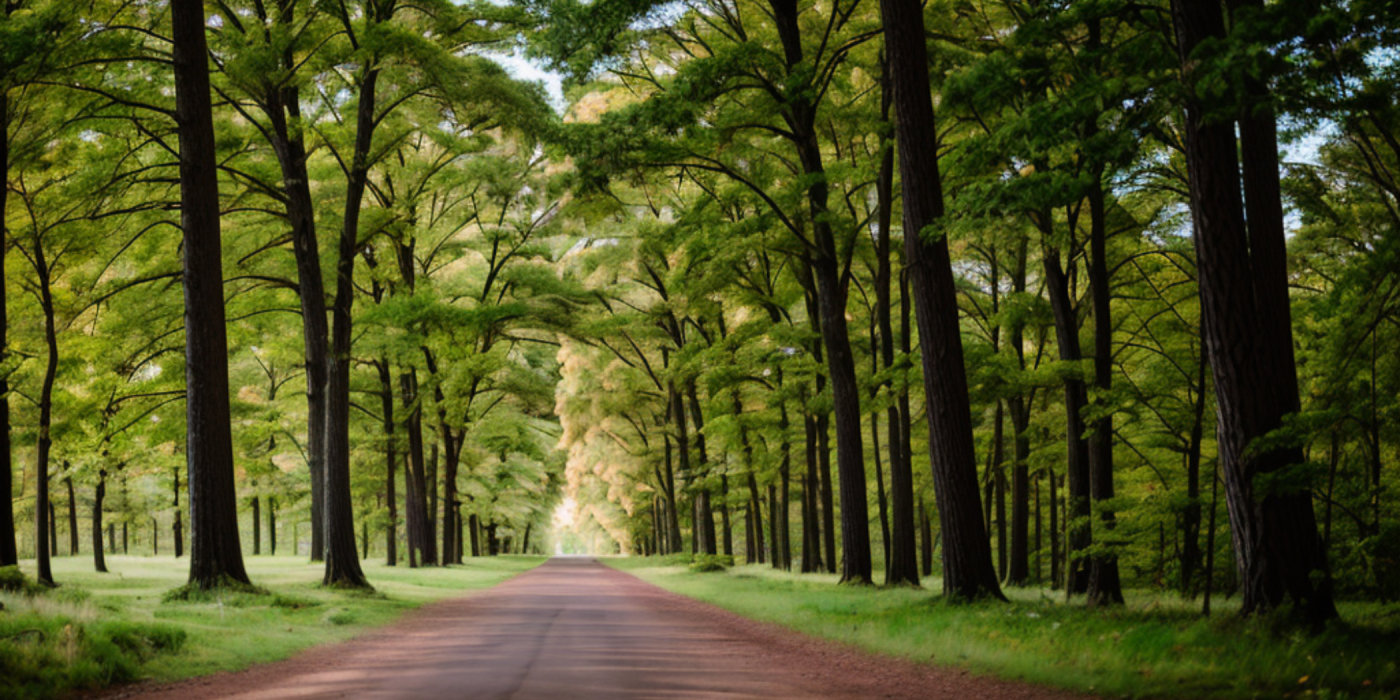Embracing the Trees: A Guide to Identification and Deepening Your Connection with Nature

Throughout the United Kingdom, from the rolling landscapes of the Cotswolds to the rugged Highlands of Scotland, trees stand as both magnificent landmarks and silent witnesses to time. These gentle giants are not only emblematic of our natural heritage but also crucial elements that weave the very fabric of our ecosystem.
Ecological Importance of Trees
Trees play an indispensable role in upholding the ecological balance of our environment. They act as the Earth's lungs, absorbing carbon dioxide and releasing life-sustaining oxygen. Beyond this, trees provide shelter and food for a myriad of wildlife, from the tiniest insects to majestic birds of prey. Their roots anchor soil, preventing erosion, whilst their canopies offer shade and regulate temperature, making areas more hospitable.
Aesthetic Value and Beauty
Beyond their ecological role, trees embellish our surroundings with an unparalleled aesthetic charm. Every season brings about a transformative beauty – the fresh verdant growth of spring, the lush canopies of summer, the myriad hues of autumn, and the stoic bareness of winter. Each tree, whether standing solo in a meadow or as part of a dense woodland, contributes to the scenic tapestry of the British landscape.
The Quest for Knowledge
Yet, as we marvel at their beauty and reap their ecological benefits, how often do we truly recognise the trees around us? Understanding and identifying the myriad tree species in our locale not only enriches our appreciation of nature but also deepens our connection to the land we call home.
Why Tree Identification Matters
While the verdant green canopies and the rustling leaves might captivate any passerby, understanding the trees in our surroundings goes beyond mere aesthetic appreciation. Identifying trees and being cognisant of their species carries implications for biodiversity, our cultural history, and practical benefits for many in the community.
Biodiversity and the Role Trees Play
Trees are pivotal pillars of biodiversity, creating habitats and sustenance for a myriad of species. Each tree species, in its unique way, contributes to the ecological balance of its environment. For instance, the Oak tree, a quintessential British staple, is home to over 280 different species of insects alone. Recognising each tree helps us understand and appreciate the intricate web of life it supports.
Historical and Cultural Significance
Throughout the UK, certain trees have stood as silent witnesses to history, garnering tales and legends in their shade. The Yew trees found in churchyards are often older than the churches themselves, with some estimated to be over a thousand years old. Identifying these trees and knowing their stories helps us foster a deeper connection with our land and its rich tapestry of history.
For the Green Thumbs and Nature Enthusiasts
For gardeners and homeowners, knowing tree species can be pivotal. It aids in making informed decisions about planting, caring for, and maintaining trees in gardens and landscapes. Moreover, for nature enthusiasts, identifying trees adds another layer to nature walks and hikes, enriching the overall experience.
Starting with the Basics: Tree Anatomy
For many, trees symbolise nature's grandeur, standing tall and resolute, bearing witness to history while providing shade, oxygen, and beauty. Yet, beneath their impressive stature lies a complex anatomy that's both fascinating and instructive. As we delve into the basics, we uncover the primary components that make up these woody giants.
The Primary Components
-
Roots: Often hidden beneath the ground, the roots anchor the tree, drawing in water and nutrients essential for growth.
-
Trunk: The main stem of the tree, the trunk supports the branches and leaves, and is comprised of multiple layers, including the bark, which protects the tree from external threats.
-
Branches: These extend from the trunk, supporting leaves, flowers, and fruits, playing a pivotal role in photosynthesis and reproduction.
-
Leaves: Crucial for photosynthesis, leaves are where the tree converts carbon dioxide, sunlight, and water into oxygen and glucose. The shape, arrangement, and texture of leaves often aid in tree identification.
-
Flowers: While not present on all trees, flowers are the reproductive organs, leading to the formation of fruits and seeds.
-
Seeds: Ensuring the continuation of the species, seeds contain embryonic plants and can be found within fruits or cones, depending on the tree.
Crucial Terminology
To further our understanding, there are a couple of terms that are fundamental when discussing trees:
-
Deciduous: Trees that shed their leaves annually, typically in autumn. Examples in the UK include the Oak and Beech.
-
Evergreen: Trees that retain their leaves throughout the year. In Britain, the Scots Pine and Holly are notable evergreens, maintaining a green facade even during the chilly winter months.
Recognising and understanding these basic components and terms not only enhances our appreciation of trees but also lays the groundwork for more advanced tree identification and knowledge.
Key Characteristics for Tree Identification
Identifying trees, much like understanding individuals, involves recognising distinct characteristics. Each tree, with its unique combination of features, tells its own story. Here, we delve into some fundamental traits that will assist you in distinguishing one tree from another.
Leaf Characteristics
Trees can often be identified with a glance at their leaves. It's essential to consider:
- Shape: The overall shape of a leaf – whether it's heart-shaped, oval, or lobed – can be a primary clue.
- Arrangement: Observe how leaves are attached to the stem. Are they opposite each other or alternate?
- Type: Some trees, like pines, have needles instead of typical leaves. Others may have compound leaves comprising multiple leaflets.
Bark Features
The bark provides a protective outer layer for trees and varies significantly across species:
- Texture: Some trees have smooth bark, while others might exhibit a rough, peeling, or furrowed texture.
- Colour: Though many might assume tree bark is universally brown, it can range from silvery white (like the Silver Birch) to dark grey or even reddish hues.
Floral and Fruity Signatures
- Flowers: Trees blossom in an array of colours and shapes. Observing the flower structure and its blooming season can be instrumental in identification.
- Fruit: From the acorns of an oak to the berries of a rowan, the fruit type and appearance offer more identification hints.
Growth Habit and Silhouette
Lastly, observing a tree's overall growth pattern and silhouette against the sky can give away its identity. The spread of its branches, its height, and its general form all play their part in the tree's distinctive profile.
Utilising Field Guides
Trees, with their myriad species and variants, can at times be quite challenging to identify. For the keen observer and the budding botanist alike, a well-structured field guide can be a game-changer. These guides are designed not only to aid in identification but also to immerse the reader in the fascinating world of trees.
The Merits of a Robust Field Guide
At the heart of any nature exploration, a good tree field guide offers a wealth of information. More than just a tool for identification, it's a conduit to understanding the history, ecological role, and unique characteristics of each tree species. The vivid illustrations and photographs complement descriptive texts, ensuring a holistic learning experience.
Top British Tree Guides to Consider
The UK boasts of a rich tapestry of native trees and thus, it's no surprise that there are numerous guides tailored for British audiences. Some noteworthy mentions include:
- "The Collins Tree Guide" by Owen Johnson and David More: A comprehensive look into British and European species.
- "The British Tree Identification" by Paul Sterry: Renowned for its detailed photographs and user-friendly layout.
- "Trees of the British Isles" by Keith Rushforth: An insightful dive into the ecology and identification of local species.
Maximising Your Field Guide Experience
For an effective use of your guide:
- Start local: Focus first on trees common to your area. This provides a solid foundation before diving into rarer species.
- Engage your senses: While visuals are pivotal, don't neglect other senses. Feel the texture of the bark, observe the scent of the flowers, and listen to the rustle of the leaves.
- Practice regularly: Just like any skill, tree identification improves with practice. Regular outings with your guide can significantly enhance your proficiency.
Tapping into Local Expertise
The UK boasts a rich tapestry of woodland environments, from the ancient Caledonian forests of Scotland to the newer woodlands of the Home Counties. While field guides and online resources can be invaluable, there's nothing quite like the insights of those who've dedicated their lives to understanding our native trees.
Engaging with Local Tree Societies and Arboretums
Britain is home to numerous tree societies and arboretums – treasure troves of expertise and localised knowledge. By joining or even visiting these organisations, you open yourself up to a wealth of first-hand information. These institutions often conduct studies, preserve endangered species, and serve as custodians of our native tree heritage. Engaging with them not only provides knowledge but also opportunities to contribute to tree conservation efforts.
Participating in Guided Tree Walks or Workshops
There's a certain magic in walking amidst trees with someone who can narrate their tales. Guided tree walks and workshops, often organised by local councils, nature reserves, or passionate individuals, offer immersive experiences. Here, you can witness tree identification in real-time, ask questions, and deepen your appreciation of Britain's sylvan beauty.
Benefits of Networking with Local Botanists and Tree Enthusiasts
Rubbing shoulders with local botanists or tree enthusiasts can be enlightening. These individuals, with their years of experience and passion, can share anecdotal tales, shortcuts to identification, and tips that aren't found in books. Networking can also lead to collaborative projects, tree planting initiatives, or simply foster a community of like-minded tree lovers.
In the end, tree identification isn't merely a skill, but a journey. And every local expert you engage with becomes a part of that enriching journey.
Common Trees in the UK: A Snapshot
The United Kingdom boasts a rich tapestry of trees, each with its distinct characteristics, historical significance, and ecological importance. Let's take a brief sojourn through some of the most iconic and prevalent tree species gracing the British landscapes.
Oak (Quercus robur and Quercus petraea)
The mighty oak is symbolic of strength and endurance. Predominant in many of our woodlands, the oak can be identified by:
- Leaves: Lobed, with small ear-like extensions at the base.
- Bark: Deep fissures and a greyish hue.
- Acorns: Oval or round, seated in a rough cup.
Beech (Fagus sylvatica)
The beech tree is revered for its smooth, silvery bark and expansive canopy, often gracing landscapes with a carpet of golden leaves in autumn.
- Leaves: Smooth, oval, with wavy edges.
- Bark: Smooth and grey, often adorned with moss or lichens.
- Nuts: Small, triangular and encased in spiky husks.
Scots Pine (Pinus sylvestris)
The only native pine in the UK, Scots Pine stands tall with its distinctive orange-brown bark.
- Needles: Paired, slender, and bluish-green.
- Bark: Flaky, orangey on the upper trunk and greyish below.
- Cones: Ovoid, reddish-brown with raised scales.
Silver Birch (Betula pendula)
Graceful and slender, the Silver Birch is instantly recognisable by its white bark.
- Leaves: Small, triangular with toothed edges.
- Bark: White and papery, peeling off in layers.
- Catkins: Long, yellow for males, and green for females.
Gaining proficiency in identifying these common trees is a gratifying pursuit, offering a deeper connection to the verdant beauty of the UK.
Tree Identification Challenges and Solutions
Identifying trees might seem straightforward, especially with the plethora of information at our fingertips. However, even the most seasoned botanists occasionally find themselves puzzled by a tree's elusive identity. This is, after all, a science intertwined with art. Let's delve into some common challenges faced in tree identification and the resources that can assist in navigating these obstacles.
Common Pitfalls
While every tree is unique, certain species bear striking resemblances, leading even the keenest of eyes astray. Some frequent mistakes include:
- Misinterpreting Seasonal Changes: Trees can look vastly different across seasons. A tree in full summer bloom might be unrecognisable come winter.
- Over-relying on a Single Characteristic: Solely relying on leaf shape or bark texture can sometimes be misleading, as these can vary even within the same species.
- Environmental Factors: Trees grown in different conditions, like urban vs. rural settings, might show variations in their typical appearances.
Navigating the Challenges
Thankfully, with advancements in technology and a rich community of tree enthusiasts, there are several tools and resources at our disposal:
- Mobile Apps: There are myriad apps available that use image recognition to identify trees. Just snap a photo, and these apps will offer potential matches, often with added information about the tree.
- Online Communities: Forums and social media groups dedicated to tree identification can be a treasure trove of knowledge, with members more than willing to assist in tricky identifications.
- Local Workshops: Attending hands-on workshops can provide practical training, helping you sharpen your identification skills and build confidence in the field.
Remember, practice is key. As with any skill, the more you immerse yourself in the world of trees, the more adept you'll become at identifying them.
Conclusion
As we wind down our journey through the captivating world of trees, it's worth pausing to truly appreciate the beauty and complexity of these natural wonders. Standing tall and firm, trees not only grace our landscapes with their splendour but also play a pivotal role in maintaining the delicate ecological balance.
Reconnecting with Nature
Delving into the art of tree identification allows us to reconnect with nature on a profound level. There’s a certain magic in being able to name the trees that you pass by every day, to understand their life stories and historical significance. It isn't just about naming; it's about acknowledging their silent contributions, from the air we breathe to the shade they provide on a sunny day.
The Power of Knowledge
Embracing the knowledge of tree identification isn't merely an intellectual exercise. It's a step towards deeper eco-awareness. By understanding the trees that share our local environment, we become more attuned to the changes and challenges they face, from diseases to the impact of urban development.
Enriching Personal Experiences
For many, this newfound knowledge deepens the enjoyment of simple pleasures – from woodland walks to lazy afternoons in the garden. The trees, with their whispers of ancient tales and seasonal rhythms, become familiar friends, enriching our everyday experiences.
I do hope you have enjoyed this article and hope that you will subscribe to my newsletter so you can get the latest information about all things naturally relaxing.
Stay in touch, join the Naturally Relaxing Newsletter
Newsletter Signup
Post Your Comments
or post as a guest
Be the first to comment.
Latest articles in Nature

Exploring the UK’s Most Serene Coastal Trails

The Healing Power of Nature: Forest Bathing Explained

Sustainable Gardening: Tips for Growing Your Own Herbs

The Yellowstone Supervolcano: A Sleeping Giant

The Lost City of Atlantis: A Geological Mystery






